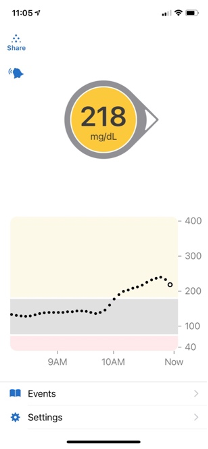

Written and clinically reviewed by Marissa Town, RN, BSN, CDCES
Imagine you have a device on you at all times that clearly shows every up and down of your blood sugar levels, and someone else is watching those levels. And it’s not just the data that is on display, but sometimes it can be all of the emotions of diabetes out there for others to see, too.
Although many people with diabetes try our best not to feel emotions about our blood sugar levels, it’s almost impossible not to feel disappointed about a high blood sugar. To think, oh yeah, I must have not counted the carbohydrates in that bagel I just ate (current situation IRL – see image), and judge ourselves for making what we perceive as a mistake.
We know that if we are judging ourselves, everyone else must thinking the same thing we are thinking. What did she do? Why did she choose to eat that bagel? Why didn’t she exercise more? I thought she was “in control.” I thought she was a “good diabetic.” It can be really difficult to summon the courage to share this part of ourselves with someone else, but there are definitely some benefits to sharing data. And some really important conversations can result from sharing, too.
Psychologist Dr. Bill Polonsky and researcher Dr. Addie Fortmann conducted a study that looked at 302 adults with diabetes who wear the Dexcom G5 or G6 system that has the capability of sharing data in real-time.1 The researchers interviewed the participants first, and based on the interviews, developed a questionnaire. The questionnaire collected information on how the participants feel about the way their interaction with their main follower has improved or worsened, perceptions of data sharing and quality of life outcomes.1 They also completed a Hypoglycemia Confidence Scale, Diabetes Distress Scale, and an overall well-being survey.1
The key items they learned from this data collection were that because of data-sharing with a chief follower, who is usually a spouse or person with diabetes, participants had the following outcomes:1
- 89% felt more peace of mind
- 5% felt less alone with diabetes
- 4% felt more confident in avoiding and treating low blood sugars
- 4% self-reported higher quality of sleep
- 2% self-reported severe low blood sugar events
- 3% self-reported HbA1C improvement
- 9% said their chief follower offered encouragement when they noticed struggles with BG management
There are some definite limitations on this data, with most participants non-Hispanic white (88.1%) and 58.3% college educated.1 Additionally, 17.5% of people felt that their follower was bothering them about their data and 14.6% felt their follower had a lack of understanding about what to do with the data they received.1
Diabetes is not a one-size-fits-all condition, and it’s important for you as the person with diabetes to have open and honest conversations about how following will affect you and your relationship with your data follower. At Friends for Life conferences, we have had MANY conversations about data sharing with parents, adults, and kids alike. Those who find ways to successfully navigate the conversations tend to have a more positive outcome.
But doing this can be challenging for all of us, and “success” depends on the dynamics of the relationships. For example, for parents who have kids with diabetes, they may feel that they want to follow their data for their child’s safety, and the child may have to go along with it despite how they feel. This does not mean, however, that the conversations have to have a “it’s my way or the highway” undertone.
For me, as an adult with diabetes, my husband Adam is my “chief data follower,” and the conversations when he first started following me were more frequent. Later on, on when he got an Apple watch and had notifications dinging frequently from his own wrist, I had to remind him that constantly reaching out to me when I’m awake and already dealing with the blood glucose management was not going to work for me.
![]()
![]()
A mom and teenage daughter out of Michigan developed an app called “Emoticons” which you can download for free, and it has all kinds of emojis for diabetes (see image to the right). Another young adult with diabetes developed a way to text back and forth with her parents that worked best for her: only communicating in memes. There’s no one-size-fits-all to data sharing and communication strategies, but finding what works for you and your loved ones can make all the difference.
I also really enjoy letting people who are learning about diabetes follow my data to help them gain insight into the daily ups and downs of diabetes, and hopefully help them respond to their loved ones, patients, or whomever with more compassion. But it took me some time to get to a point of feeling comfortable with sharing my data this openly.
There are many ways to navigate sharing data, and it can be really valuable to have a back-up person keeping their eye on you. It takes a village, as the saying goes, and we hope encouraging discussions like these this can help you fortify your village!
- https://www.ncbi.nlm.nih.gov/pmc/articles/PMC7906862/
- https://diatribe.org/can-i-follow-your-cgm-having-conversation-about-sharing-your-data

